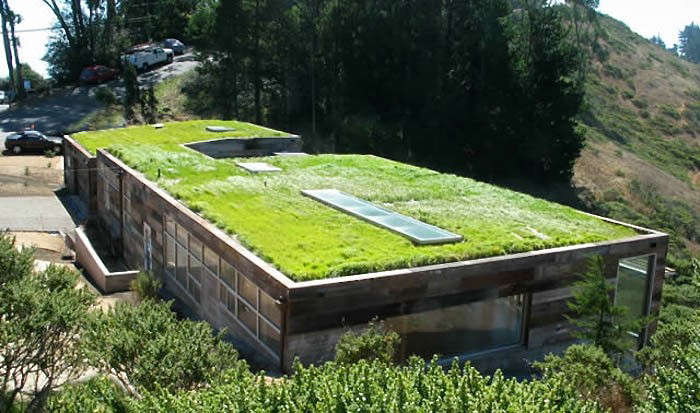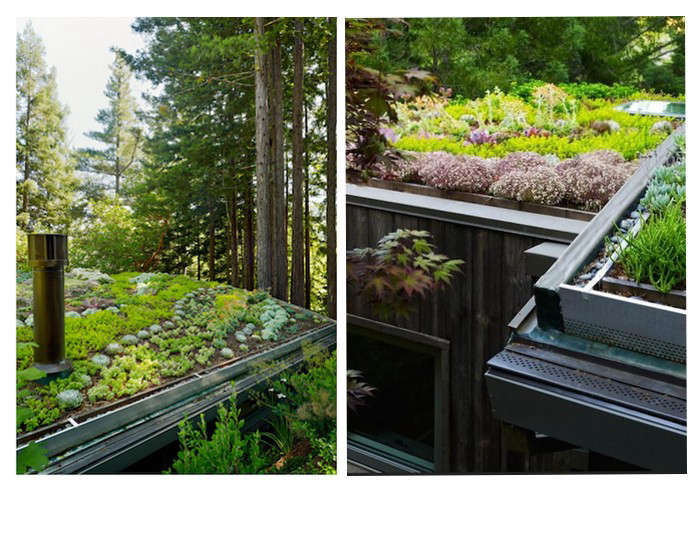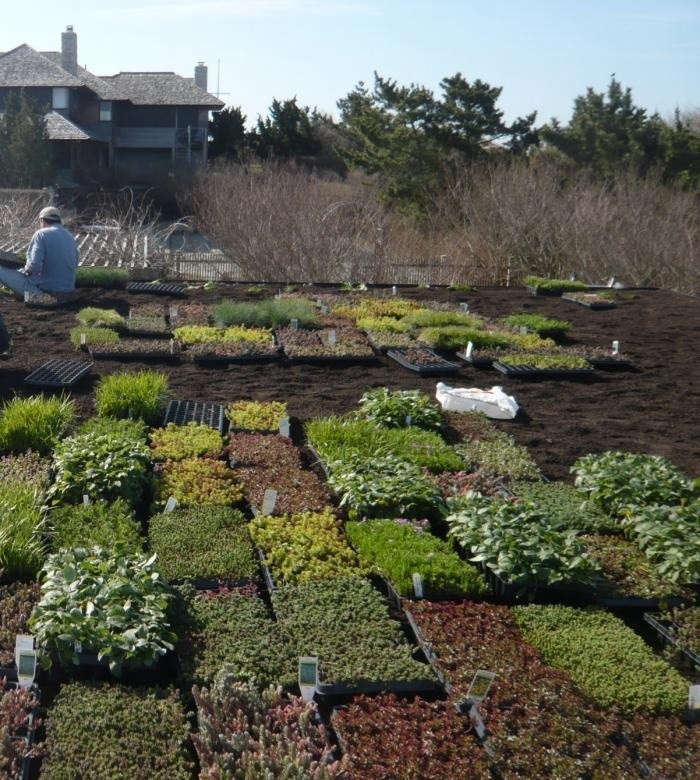In our ideal world, green roofs would be ubiquitous–we’re thinking Scandinavia from the time of the Vikings until the late 19th century. And no, it’s not because we are nostalgic for a more picturesque past. We’re actually looking to create a new future, one where entire town roofscapes are living and green, leaving the legacy of a healthier environment. How difficult would that be, we wanted to know? Here’s what we found.
Above: A green roof tops an artist’s cottage, designed by Remodelista Architects & Designers Directory member Feldman Architecture. Photograph by Joe Fletcher.
What is a green or living roof?
A green or living roof is a specially engineered rooftop that supports vegetation and plant life to the benefit of the environment. There are three categories of green roofs; depending on how deep the planting medium is and how much maintenance they require: intensive, semi-intensive, and extensive. Intensive green roofs recreate the conditions of a traditional garden above ground and are require substantial effort to maintain. At the opposite end of the spectrum are extensive green roofs, which are self-sustaining with tough and drought-resistant plants, making them relatively maintenance-free (they’re the ones we’d like to see everywhere).
Above: A living roof designed by Rothschild/Schwartz for a couple nearing ninety in Sausalito, CA keeps the house cool in summer and warm in winter. Photograph via Rothschild/Schwartz.
How are green roofs good for the environment?
We all know the benefits that plants and vegetation provide for the environment. Green roofs in urban environments pack an extra punch because they replace greenery lost to dense neighborhood blocks of buildings.
Green roofs reduce air pollution through plant respiration while mitigating against heat gain as the plants absorb and retain the sun’s warmth. Traditional roofing materials, on the other hand, re-emit the sun’s heat and cause temperatures in cities to be higher than in surrounding rural areas.
With their ability to absorb rainwater and act as a filter, green roofs decrease surface runoff, keeping water supplies freer of pollutants while reducing the chances of flooding. Buildings with green roofs have built in thermal insulators and do not require as much power to heat and cool. And finally, green roofs create valuable habitats for wildlife, helping to preserve and promote biodiversity for the future.
Above: A detail of the drainage and gutter system for a green roof designed by Feldman Architecture. Photograph by Joe Fletcher.
How are green roofs made?
Modern green extensive roof systems are from 1 to 4 inches thick and are composed of manufactured layers that support a growing medium and vegetation. The five primary layers include a waterproof membrane, a root protection barrier, a drainage layer, a growing medium, and plants.
Above: A diagram of a green roof and its component layers. Image via Safeguard Store.
What types of plants will grow on a green roof?
The two most important factors to consider when choosing plants are how much maintenance you want to undertake and how sunny your roof is. Remember when selecting your plants that many will have a dormant period, so if you want green color year round, add some evergreens to the mix. A general rule of thumb is that the more variety you plant, the thicker your growing medium must be, which increases the weight of your roof.
Above: Pallets of plants ready to be installed on a 1,000-square-foot green roof designed by Alive Structures. Photograph courtesy of Marni Majorelle.
How much maintenance does a green roof require?
At the minimum, an extensive 4-inch green roof system planted with mixed sedums (low-maintenance plantings) in its first year requires watering and weeding every few months. In the second year, it only will need to be weeded three or four times and after that, just once a year. You will need to fertilize once a year.
At the other end of the spectrum, depending on what you plant, maintenance requirements can increase to the point where you might want to consider an irrigation system. See Hardscaping 101: Drip Irrigation for details.
Does the weight of a green roof require additional support?
Green roofs weigh more than traditional roofing materials and if you are considering installing one, it is best to consult with a structural engineer. While new construction can easily be designed to incorporate the weight loads of a green roof, retrofitting existing buildings requires careful consideration.
Above: A green roof in San Francisco by Feldman Architecture.
How much does a green roof cost and how long will it last?
Standard 4-inch flat, extensive green sedum roofs are estimated at costing between $10 to $20 per square foot including materials, preparation and installation (which is significantly more expensive than the installation of a Traditional Asphalt Shingle Roof at an average of $1.20 a square foot). By protecting the roof membrane, however, a green roof can extend the life of a roof by two or three times beyond its typical lifespan. In Europe, where they have been building with green roofs since the 1960s, green roofs have been known to last for from 30 to 50 years.
Above: Prickly pear (L) planted with blue fescue and native wildflowers on a New York City roof designed by Alive Structures.
Green roof recap:
Pros:
- Good for the environment
- Lower utility costs because of a green roof’s thermal insulation properties
- Low-maintenance
- Long life
Cons:
- Significantly higher initial installation costs than traditional roofs
- Heavier weight may mean incurring additional structural costs
Want to see more? Remodelista Architect and Designer Directory member Jonathan Feldman and landscape architect Jori Hook design two green roofs for Cottages in the Mill Valley Forest while we take a tour of the Academy of Sciences’ Rooftop Garden. For more renovation ideas, see our catalog of Remodeling 101 and Hardscaping 101 posts.



















Have a Question or Comment About This Post?
Join the conversation (4)